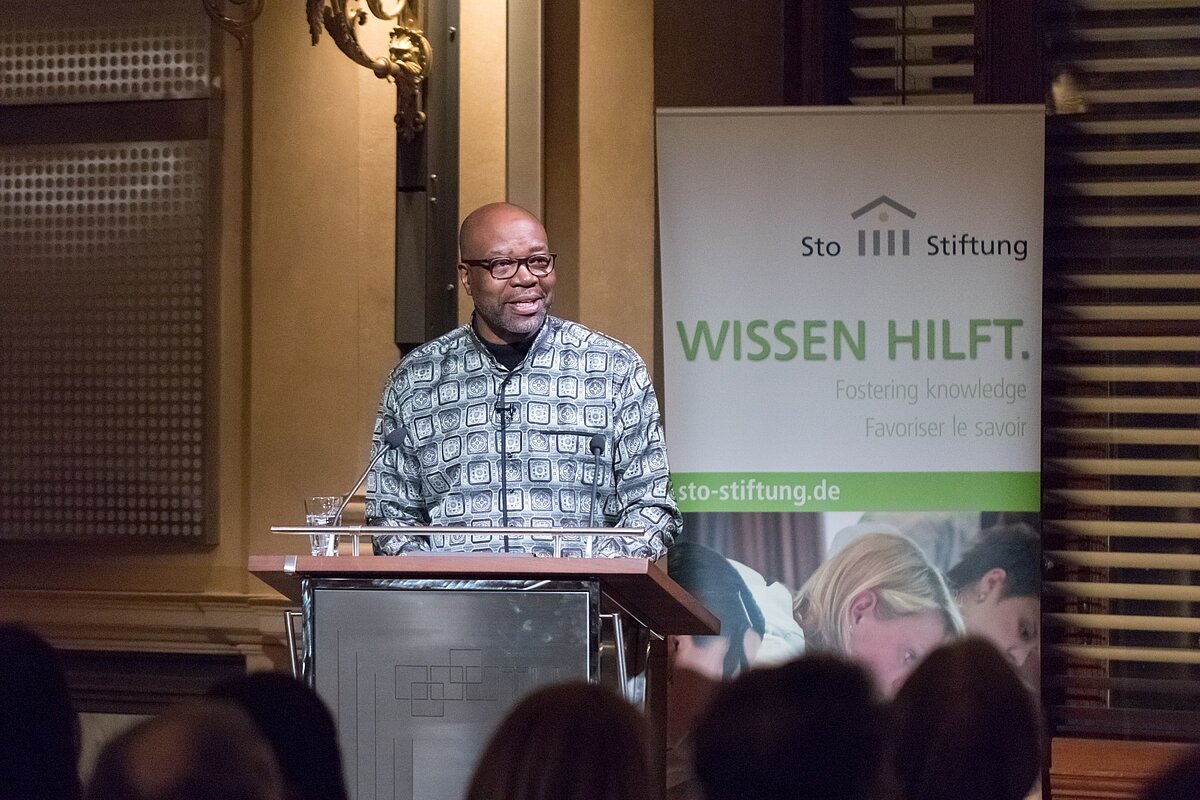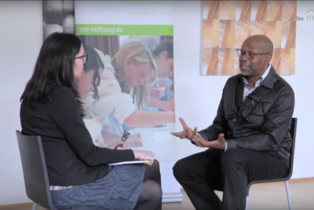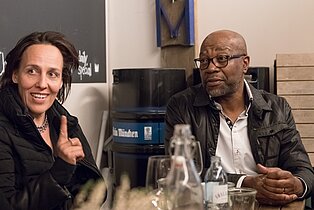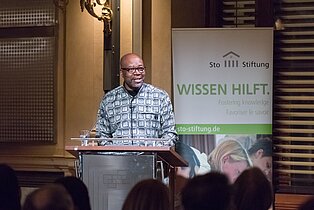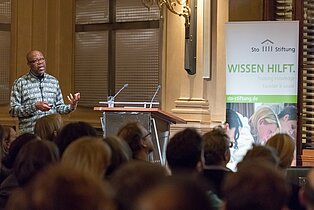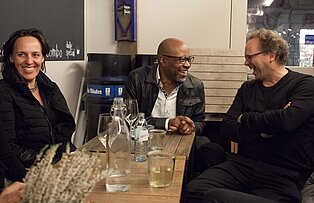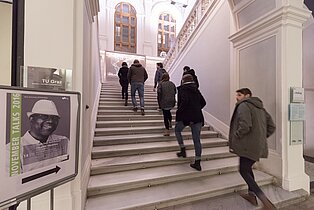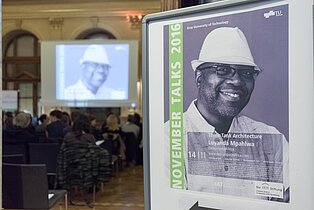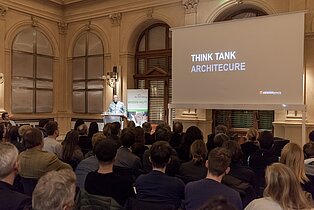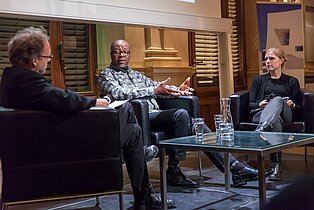Luyanda Mpahllwa | Design Space Africa | Cape Town
November Talks 2016 in Graz: "The Architecture of Change"
With its 20th lecture, the Sto Foundation’s “November Talks” explored a new dimension: In addition to covering contemporary architecture, the talks in 2016 were also geared towards the socio-cultural and socio-political implications of architecture. Luyanda Mpahlwa was first up on 14 November 2016. The architect from Cape Town impressively demonstrated how architecture can change environments – but never forgets people in the process.
A never-ending sea of low-rise shanties – and at the horizon the silhouette of a modern, vibrant city centre. That is the look of many of the world’s megacities such as Mumbai, Bogotá or Cairo. Or that of the South African city of Cape Town. Luyanda Mpahlwa, born in Mthata (South Africa) in 1958, calls the transformational process that is supposed to improve the lives of the people in these ever-increasing peripheral residential areas "slum upgrading". To build them a European-style multi-storey residential block would accomplish nothing, he believes: "That would just cause the people to feel uprooted. Informal settlements are still being created. People are using their own materials and the community is strong". In order to upgrade slums, people have to be part of the change. That is the only way to get them to identify with the living space.
Luyanda Mpahlwa directly experienced one of the biggest changes in world history – the end of Apartheid. When student protests reached their climax, he was just graduating from college. He was arrested as an anti-Apartheid activist in 1981 and incarcerated in the Robben Island prison. Five years later, with the help of Amnesty International, he went into exile in Germany, where he finished his architecture studies at the Technical University in Berlin. In 2000, he returned to Cape Town and opened an architecture office. Nowadays, together with his wife Ulrike Mpahlwa and his newest office, DesignSpaceAfrica, he works on changing Cape Town and South Africa – not politically but architecturally. However, he believes those two things can't really be separated. "As architects, we are not just dealing with buildings," he said, "but also with environments and situations. The time in which it was just about creating shapes is long gone. The role of architecture is defining itself anew."
That means that the way people build also has to be re-thought completely. When concrete and wood are too expensive, other ways have to be found. For example, connecting struts are filled with sand bags and everything is then covered with plaster. "10 x 10 Sandbag Housing" is the name of this low-cost construction method that has won multiple awards. In the Freedom Park Township, an entire settlement of two-story residential buildings, which are both colourful and playful, was created with this technique. The best thing about it: One bag only weighs 7 kg. The entire community obviously assists in the construction of their houses – just like it would have done for a shanty as well. On the ground floor, the new houses create a space that is necessary for a life that traditionally takes place outside – trade, commerce, social life. "You have to allow people to participate in the change," Mpahlwa emphasised.
The sandbag architecture was also used in the Philippi Township. A soup kitchen for 200 children was built using the same technique. Two-storeys, colourful, inviting, child-friendly. Mpahlwa is also designing a corresponding afternoon care centre. In spite of a tight budget, a paradise for children was created that looks like it was constructed with colourful building blocks. Electricity is valuable, which is why Luyanda Mpahlwa has allowed the building to be flooded with sunlight. The future of the children – which means the education they can get in a school – is pivotal to positive change in South Africa. "Beyond the River: 50 Schools" is the name of the ambitious project that is challenging the windowless and bleak "slum schools" of eastern Cape Town. Within two years and spending just a little bit of money, the Department of Basic Education replaced 50 school buildings in the rural area. The design came from Luyanda Mpahlwa. The logistics alone seemed to be an obstacle that could not be overcome: "Without helicopters, a lot of places were inaccessible". But with clever planning and material selection, and thanks to perfectly coordinated teamwork, classrooms, libraries, laboratories and modern equipment for the students, teachers and the school administration were quickly created – 50 times. When it came to the sanitary facilities, a decision in favour of dry toilets, which are also being used in the national parks, was made. The teaching staff received special training that allowed them to operate the facilities in a professional manner, meaning they can be used sustainably. Single-storey buildings are grouped around a bright courtyard. Once again, they are friendly, bright, child-friendly and inviting. "Architecture nowadays means to think about the relevance of our work and to design inclusive instead of exclusive living spaces", said Luyanda Mpahlwa. In other words: to bring about change.
Video-Interview withLuyanda Mpahllwa
Visit our YouTube-Kanal der Sto-Stiftung
Luyanda Mpahlwa, architect and urban designer in Cape Town, studied architecture at the Durban University of Technology until he was imprisoned in 1981. After he was released, he finished his Master's degree in exile at the Technical University of Berlin. He returned to South Africa in 2000 and founded the office DesignSpaceAfrica in 2009. Together with a consortium of architects, he was involved in building South Africa's embassy in Berlin. His project "Beyond the River: 50 Schools" was exhibited at the2016 Venice Biennale. He received an honorary doctorate degree for his architectural innovations from Walter Sisulu University. The sandbag buildings received the Curry Stone Design Prize in the USA in 2008. He and his office are currently working on a development plan to improve the conditions of the Kosovo Township in Cape Town.


